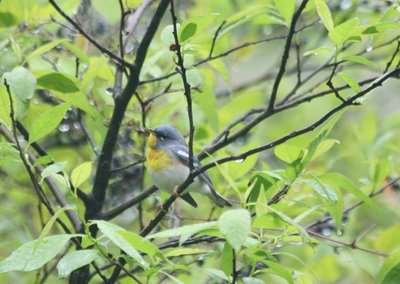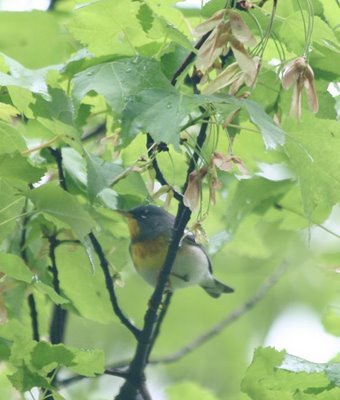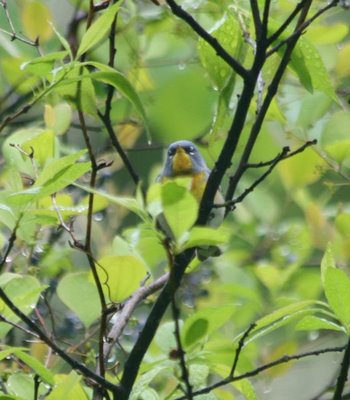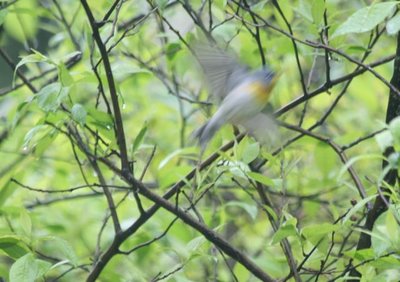Parula Interlude
Six years ago, I gave the inaugural keynote at the very first New River Neotropicals Festival, which has now evolved into the New River Birding and Nature Festival. The talk was about the natural history of wood warblers, with details about their lives, their foraging behavior, and their habitat use on the wintering grounds. Having given a talk every year since, I finally ran out of talks, and had to recycle this one. Whereas I'd used a Carousel slide projector in 1992, this time I had slick new photos in a Keynote presentation. And this year, I had a whole new section on threats to warblers, culminating in mountaintop removal mining. It wasn't fun to talk about such a thing at this festival. But a lot of people thanked me for making them aware of it, and I felt better when it was over.
Bill and I give talks at this festival, and we also lead field trips. Most of these convene at 6 AM with a very nice hot breakfast (eggs, bacon, the whole works) under a picnic shelter, and then everyone loads into those long church vans (most of them borrowed from the Baptist church in Oak Hill) to go to different warbler watching sites.
You can see 23 different species of warblers around Fayetteville, West Virginia. Not migrating, but breeding, on territory. These rumpled mountains hold the highest diversity of plant and animal species outside the tropical rainforest. Sometimes, well a lot of the time, it IS rainforest.
It rained this year, started raining the minute I got out of my car on Thursday night, and it stopped raining as I got out of my van at the very end of the last field trip on Saturday afternoon. Of course, it had been beautiful the whole week before I got there, and everyone had enjoyed field trips in sunshine in this week-long festival.
So I don't have as many pictures as I usually would, and many of them were taken in pouring rain. But rain or no rain, when there are so many warblers around, it's hard to have a bad time.
The northern parula is the smallest North American warbler, smaller than a chickadee, hovering around kinglet size.

But the parula packs a lot of beauty into its tiny body.
 White eye crescents give it a quizzical look, and chestnut and blue bands adorn its breast. A peculiar olive-yellow patch marks its back. I love this head-on look.
White eye crescents give it a quizzical look, and chestnut and blue bands adorn its breast. A peculiar olive-yellow patch marks its back. I love this head-on look.
The parula's song is a buzzy, ascending trill: zzzzzzziiiiiiiip!--hard to mistake for anything else. Soon enough, the session was over, and the little parula headed for a spruce top.

It's hard to believe such things are tucked into these mountains, but they are. If only more people realized it. If you get a chance to go to this festival, grab it. If you've got holes on the warbler section of your life list, holes like golden-winged warbler and the elusive Swainson's warbler, parula, black-throated blue or Blackburnian warbler, it's the place to go. Shoot for April 27-May 2, 2009. We'll show the birds to you, serve them up on a silver platter, and your money will go toward nature education in local schools. Which I believe is the only hope for changing West Virginia's appallingly short-sighted giveaway of its very soul--its mountains--to huge international coal companies. Take down the mountains, and what will be left of "Almost Heaven?" Will people still come to hike, fish, camp, hunt and watch wildlife on exhausted, hydroseeded barrens? Will ginseng grow, or thrushes sing at twilight on what remains of SugarTree Road?
West Virginians have to come to believe there's a better way to live than by the rape and pillage that is the modus operandi of the coal companies many of them work for. Enlightenment will have to start with their children. Go to this festival. Find out what's there to save. Help fund nature education in West Virginia schools. It's a win-win deal.
And write your Federal representatives. Tell them this horrendous pillage of Appalachia must stop. Tell them to support the reinstatement of the Clean Water Act that the Bush Administration so insidiously gutted. Tell them that mine tailings are poisonous WASTE, not "fill." Tell them to call it like it is. And tell your friends. Click here to find out how.
Every time I start to write about what's so wonderful about West Virginia, every time I look at my pictures of these lovely birds in their sheltering trees, this is what comes out. We have to do something about it. Thank you for your help.
Labels: New River Birding Festival, parula warbler






<< Home